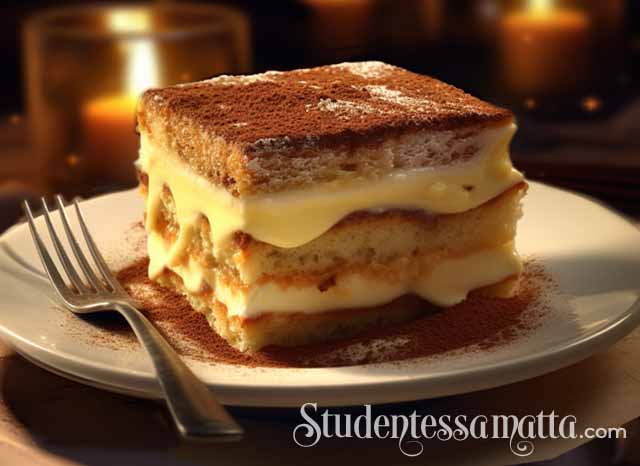
Tiramisù – salvare capra e cavoli*
Tiramisu – having your dolce and eating it too!
*In Italian, the idiom “having your cake (dolce) and eating it too does not translate. Instead, the Italians convey this idiom that means to save a potentially disastrous situation and also reap the rewards by saying “salvare capra e cavoli” (literally: save the goats and cabbages.)
Sai perché il più famoso dolce italiano si chiama Tiramisù? Gli studenti di lingua italiana, prendete un momento e pensarci! Il significato letterale della frase – tiramisù in inglese è –“pull me up” o “cheer me up.”
Do you know why the most famous Italian dessert is called Tiramisu? Students of the Italian language, take a moment and think about it! The literal meaning of the phrase – tiramisu is “pull me up” or “cheer me up.”
Tirare = to pull (verb)
Tira! (2nd person singular imperative conjugation)
Mi = me (first person singular object pronoun)
Su = Up (preposition)
Combinando l’imperativo coniugato del verbo “Tira” con il pronome oggetto e la preposizione, otteniamo “TIRAMISU.”
Combining the conjugated imperative of the verb “Tira” with the object pronoun and the preposition, we get “TIRAMISU.”

Le origini di Tiramisu suggeriscono che fu creato per
la prima volta nella regione del Veneto a Treviso
The origins of Tiramisu suggest that was created
for the first time in theregion of Veneto in Treviso
Perché si chiama una torta pick-me-up? Beh, a causa della quantità di zucchero e caffeina questo dolce contiene, è garantito per caricarti di energia. Le origini di Tiramisu suggeriscono che fu creato per la prima volta nella regione del Veneto a Treviso, da Roberto Linguanotto, il proprietario di Le Beccherie, per la sua clientela di ristoranti.
Why is it called a pick-me-up cake? Well, due to the amount of sugar and caffeine this sweet contains, it is guaranteed to give you an energetic lift. The origins of Tiramisu suggest that it was first created in the region of Veneto in Treviso, Italy, by Roberto Linguanotto, the owner of Le Beccherie, for his restaurant clientele.

Tuttavia, c’è un’altra storia più impertinente sulle origini di Tiramisù. Secondo la leggenda popolare, è stato inventato da una signora in un bordello a Treviso. Fin dal Medioevo, la città ha avuto una reputazione per i suoi costumi sessuali rilassati. Più Tiramisù consumato, più redditizio era il business della prostituzione. Il nome “Tiramisu assume certamente un significato diverso se considerato alla luce delle attività “amorose” di Treviso.
However, there is another saucier story about the origins of Tiramisu. According to folk legend, it was invented by a madam in a brothel in Treviso. Since the Middle Ages, the city has been known for its relaxed sexual mores. The more Tiramisu consumed, the more profitable was the business of prostitution. The name “Pick me up cake” certainly takes on a different meaning when considered in light of Treviso’s “amorous” activities.

Come si fa un Tiramisu?
How di you make Tiramisu?
Ci sono molte versioni di Tiramisù, ma la ricetta tradizionale richiede una stratificazione di biscotti chiamati Savoia o Savoiardi, con un ripieno di crema a base di tuorli d’uovo, zucchero, caffè, mascarpone e liquore, il tutto condito con cacao in polvere. Un po’ come la vendetta, Tiramisù è meglio servito freddo.
There are many variations of Tiramisu, but the traditional recipe calls for a layering of biscuits called Savoy or Ladyfingers, with a cream filling made of egg yolks, sugar, coffee, mascarpone cheese, and liquor, all topped off with cocoa powder. Kind of like revenge, Tiramisu is best served cold.
Finché ci stiamo immergendo in profondità negli organi dei nomi dei dolci, è interessante notare che “Ladyfingers” o “Savoiardi”, come sono conosciuti in Italia, sono stati creati nel 15 º secolo in occasione di una visita del re di Francia al Ducato di Savoia situato nel nord del Piemonte. In seguito sono stati riconosciuti come il “ufficiale” biscotto di corte.
As long as we are diving deep into the organs of the names of desserts, it is interesting to note that “Ladyfingers” or “savoiardi,” as they are known in Italy, were created in the 15th-century to mark the occasion of a visit by the King of France to the Duchy of Savoia located in northern Piemonte. They were later recognized as the “official” court biscuit.
Ricetta di tiramisù italiano
Italian Tiramisu Recipe
Istruizioni e ingredienti per 8 porzioni.
30 minuti Tempo di preparazione.
Instructions and ingredients for 8 servings. 30 minutes Preparation time.
300 g (circa 30) Savoiardi Savoiardi
500 g (1,1 lb = 2 1/4 tazze) di formaggio Marscapone
4 uova medie
100 g (1/2 tazza) di zucchero semolato
300 ml (1 ¼ tazza) di caffè (meglio se espresso)
2 cucchiai di Rum o Marsala
Polvere di cacao amaro
300 g (about 30) Savoiardi Ladyfingers
500 g (1,1 lb = 2 1/4 cups) of marscapone cheese
4 medium eggs
100 g (1/2 cup) of granulated sugar
300 ml (1 ¼ cup) of coffee (better if espresso)
2 tablespoons of Rum or Marsala
Unsweetened cocoa powder
Teglia in ceramica. Per 8 persone è necessario uno di circa 30 x 19 cm (12 x 8 pollici)
Ceramic baking pan. For 8 people you need one of about 30 x 19 cm (12 x 8 inch)
Passo 1: Fare l’espresso. Aggiungere 2 cucchiai di vino Marsala (o rum). Mettere da parte per raffreddare.
Step 1: Make espresso. Add 2 tablespoons of Marsala wine (or rum). Set aside to cool.
Passo 2: Separare gli albumi dai tuorl
Step 2: Separate the egg whites from the yolks.
Passo 3: Montare gli albumi a neve.
Step 3: Whip the egg whites until stiff.
Passo 4: Sbattere i tuorli d’uovo con lo zucchero fino a quando la luce e liscia (circa 3-5 minuti)
Step 4: Beat the egg yolks with sugar until light and smooth (about 3-5 minutes)
Passo 5: Versare il mascarpone in una ciotola e ammorbidire con un cucchiaio. Aggiungere ai tuorli d’uovo.
Step 5: Pour mascarpone cheese into a bowl and soften with a spoon. Add to the egg yolks.
Passo 6: Montare lentamente la miscela Mascarpone / Egg per circa 2-3 minuti.
Step 6: Whip the Mascarpone / Egg mixture slowly for about 2-3 minutes.
Passo 7: Aggiungere gli albumi sbattuti. Mescolare delicatamente con un cucchiaio di legno, dal basso verso l’alto fino a quando liscio e cremoso.
Step 7: Add the beaten egg whites. Mix together gently with a wooden spoon, from bottom to top until smooth and creamy.
Passo 8: Assemblaggio. Creare uno strato di savoiardi, immerso e imbevuto (ma non sopping) fianco a fianco che copre l’intera padella. Stendere la miscela di crema di mascarpone dei savoiardi. Ripetere, aggiungendo un altro strato di savoiardi e crema di mascarpone diffusione generosamente.
Step 8: Assembly. Create a layer of ladyfingers, dipped and soaked (but not sopping) side by side, covering the entire pan. Spread the mascarpone cream mixture of the ladyfingers. Repeat by adding another layer of ladyfingers and mascarpone cream spreading generously.
Passo 9: Cospargere l’intero intruglio pesantemente con cacao in polvere.
Step 9: Sprinkle the entire concoction heavily with cocoa powder.
Passo 10: Mettere la padella in frigorifero per 3 ore prima di servire.
Step 10: Place pan in the refrigerator for 3 hours before serving.

Il tiramisù è un dolce classico che non manca mai di stupire. Fallo per la tua prossima cena. Non solo i vostri ospiti a una delizia si può anche illuminarli circa le origini di questo famoso dessert italiano e insegnare loro un po’ di italiano in aggiunta!
Tiramisu is a classic dessert that never fails to impress. Make it for your next dinner party. Not only will your guests to a delicious treat you can also enlighten them about the origins of this famous Italian dessert AND teach them a little Italian to boot!












Ciao Melissa, that is the same recipe that i use but I make sure that it is quite moist and I use Amaretto, a great favourite among my friends. delizioso !!!!